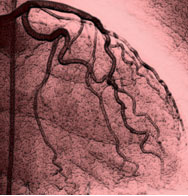Coronary angiography
23 May 2021 / 4:25 pm
What is it ?
A coronary angiogram is an investigation to identify if there are any blockages or abnormalities in your heart arteries. Coronary angiography is a useful investigation for patients with chest pain that might be angina.

How is it performed ?
Angiography is performed by passing tubes called catheters from the top of the leg or your wrist around into the heart. Local anaesthetic is injected to minimise any discomfort. You will need to lie flat on a couch so that an x-ray camera can move around your body. Contrast (dye) is then injected directly into the heart arteries to identify if there are any narrowings.
How long does it take ?
About 30 minutes.
Are there any risks ?
The main risk of the procedure is bleeding or bruising at the puncture site. Other potential complications can include heart attack (1 in 750), stroke (1 in 1000) and allergic reactions to the contrast (1 in 100). As the investigations involves x-ray there is also a risk from the radiation.
What happens next ?
You may need to lie flat for a few hours after the angiogram. The angiogram images will be analysed immediately and if a serious blockage is identified during the procedure you may be offered a procedure (angioplasty / stenting) to open the blocked artery.